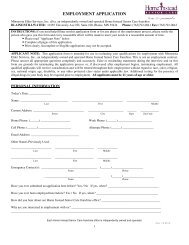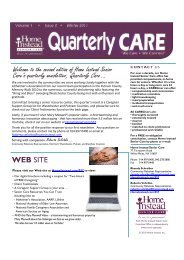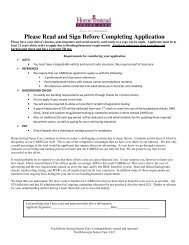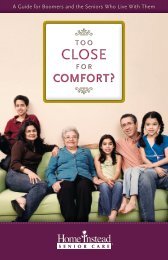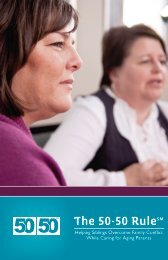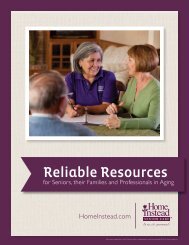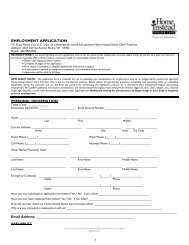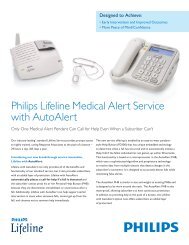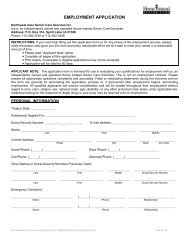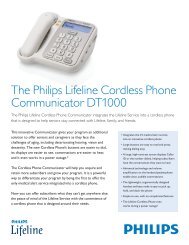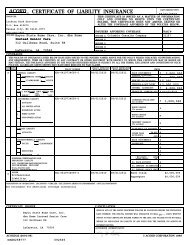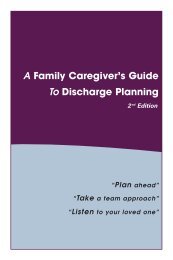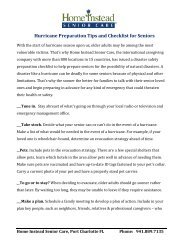Seniors and Nutrition Executive Summary - U.S. Study Results
Seniors and Nutrition Executive Summary - U.S. Study Results
Seniors and Nutrition Executive Summary - U.S. Study Results
Create successful ePaper yourself
Turn your PDF publications into a flip-book with our unique Google optimized e-Paper software.
Mealtime Challenges<br />
• Two of five seniors who live alone (44%) have at least four warning<br />
signs of poor nutritional health.* The most common of these warning<br />
signs <strong>and</strong> their incidence rates are:<br />
• I eat alone most of the time 76%<br />
• I take three or more different medications a day 71%<br />
• I eat few fruits, vegetables or milk products 46%<br />
• I have an illness/condition that made me change the food I eat 31%<br />
• I am not always physically able to shop, cook or feed myself 25%<br />
* The warning signs of poor nutritional health were previously identified <strong>and</strong> published by<br />
the <strong>Nutrition</strong> Screening Initiative.<br />
• <strong>Seniors</strong> who have been hospitalized in the last year <strong>and</strong> those with<br />
monthly food budgets of less than $100 report higher incidence rates<br />
than other seniors for several warning signs of poor nutritional health.<br />
• Nearly one-quarter of seniors (23%) say they do not always have<br />
enough money to buy the food they need.<br />
• More than one-half of the seniors (52%) eat pre-made or convenience<br />
foods either sometimes or most of the time rather than cook for<br />
themselves.<br />
• One in five seniors (20%) says he or she sometimes or most of the<br />
time feels lonely when eating alone.<br />
• According to these seniors, the biggest mealtime challenge for older<br />
people who live alone is lack of the shared family experience including<br />
companionship <strong>and</strong> conversation.<br />
The following percentages refer to<br />
the number of seniors who believe<br />
these are challenges for older<br />
people who live alone.<br />
62%<br />
60%<br />
56%<br />
56%<br />
49%<br />
45%<br />
43%<br />
41%<br />
38%<br />
35%<br />
Lack of companionship<br />
during mealtimes<br />
Cooking for one<br />
Eating nutritious meals<br />
Grocery shopping for one<br />
Eating three meals a day<br />
High expense of cooking<br />
for one<br />
Relying too much on<br />
convenience food<br />
Loss of appetite<br />
Eating too much food<br />
Eating too little food<br />
• The most common obstacles that prevent these seniors from sharing<br />
more meals with their family <strong>and</strong> friends are:<br />
• Family/friends don’t have enough time 28%<br />
• Family/friends live too far away 20%<br />
• I don’t drive 17%<br />
• I’m never asked 13%<br />
• More than one-third of seniors who live alone (37%) receive outside help with mealtime activities. Among these<br />
seniors, the most common form of help is with grocery shopping or transportation to the grocery store (81% of<br />
those who receive assistance). This help is provided by children (47%), friends/neighbors (22%) <strong>and</strong> other family<br />
members (21%).<br />
• Men are twice as likely as women to want more help with mealtime related activities, including assistance with<br />
shopping <strong>and</strong> meal preparation.<br />
• Nearly one-third of men (31%) have been told by their doctors or other healthcare professionals that they need<br />
to eat better compared with 17% of women.<br />
3



